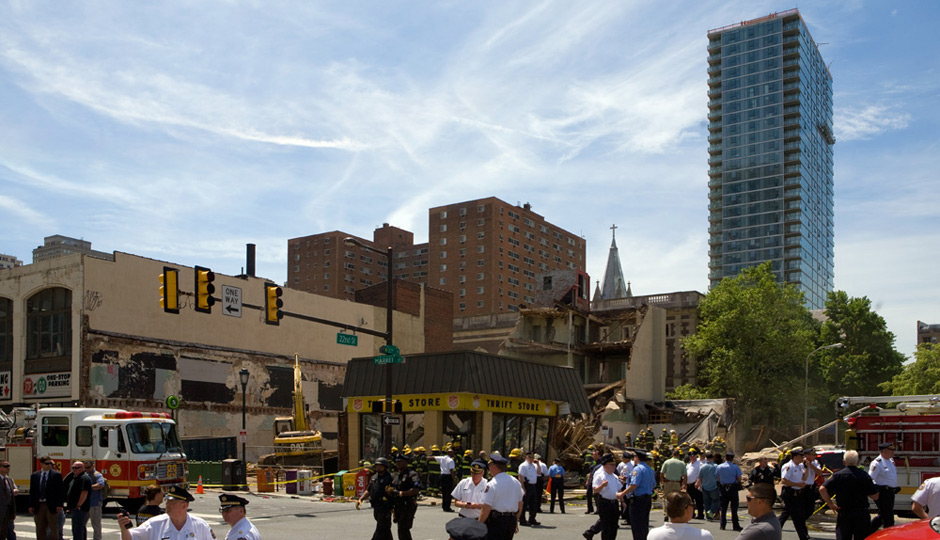Sympathy for L&I

On October 30th, Mayor Nutter announced the creation of a blue-ribbon commission to examine the Department of Licenses and Inspections (L&I) in a never-ending reaction to the June 5th building collapse at 22nd and Market Streets.
The panel is the latest in a sequence of investigation and rage after the disaster, which includes voluminous op-eds in the dailies and a formal investigation by the City Controller’s office. This chorus can lead one to believe the catastrophe was singular. In scope, it was; the collapse killed six people and was one of the largest structural disasters in recent municipal memory.
But Market Street was the Sandy Hook of building collapses. Buildings were falling before, and they have they fallen since.
In December 2012, for instance, Cedar Park Café caved in after a demolition accident at the razed Elena’s Soul next door. In late July of this year, a rowhome exploded in South Philadelphia and collapsed, injuring eight.
In mid-October, while walking home from the trolley just a block away from Cedar Park Café, I saw 50th Street blocked with police tape and a pile of rubble on a corner. A building had collapsed a week after being reported by a neighbor as a potential hazard. The neighbor said that L&I had conducted a hand demolition and seemingly followed every possible precaution. And yet, days into the meticulous demolition process, the derelict home still fell down.
“Man, that’s the ninth one,” a city employee on the scene said offhand.
“What, since June?” I asked.
“No,” he said, “this week.”
I contacted L&I spokeswoman Rebecca Swanson to confirm the number, but she didn’t respond. Just days earlier, she had sworn at me and called me a liar.
***
In August, I called Swanson, who had taken over as the chief L&I flak shortly after Market Street and asked if she had the total number of building collapses going back some number of years.
“Market Street wasn’t a building collapse,” she parried. “Why do you even want this data?”
She began defending the integrity of the L&I team and bemoaned that no one in the press has yet picked up on how good a job the agency had actually done. Swanson explained to me that I’m not the first person to request all the building collapses in the past 10 years, and that they’re not building collapses anyway. The department’s categories of structural disasters are maddening and boring, but the only way I would get any data on them is by using the right categories.
We struck a deal: She would give me data dating back all those 10 years on whatever structural disasters occurred and set up an interview with L&I Commissioner Carlton Williams, who no one in the press had actually sat down and spoken to.
In return, I would listen to the sympathetic side of the story Swanson felt hadn’t been told. And that seemed reasonable. No matter how much people loathe it, L&I isn’t the Parking Authority, even if L&I’s reputation is only slightly less tarnished.
Property owners didn’t like L&I because it often felt like the embodiment of bureaucratic frustration at its worst; good-government advocates criticized it as a depository of patronage positions; and now, citizens at large didn’t like that it failed to prevent a building from collapsing (or whatever it technically did) and killing six people. I started to understand the pressure of being the point person for all the probes and demands launched at the agency.
Each week, I followed up on the data and a date to talk with Williams, and each week, Swanson assured me that the data was forthcoming. She suggested that before I sat down with the commissioner, I should have a preliminary meeting with her.
One month after beginning the process, we scheduled a sit-down for a Tuesday. The day of the sit-down turned out to be the day that news broke of city controller Alan Butkovitz’s threat of a subpoena for demolition records.
Swanson cancelled the meeting and didn’t respond to repeated follow-ups.
***
Two weeks later, I wrote a story summarizing the spat between Butkovitz and L&I. Before publication, I sought comment from both Swanson and mayoral spokesman Mark McDonald. The agency, I told McDonald, seems to have adopted a reclusive PR style; my meeting with Williams never came, and I was still waiting on data.
“Do you want to interview the commissioner?” he asked in a way that sounded rhetorical, as if he assumed my interest had waned.
It hadn’t. “Yeah, I do.”
One, maybe two seconds, and then, “Okay.”
Fifteen minutes later, Swanson reemerged. Williams could meet the following Tuesday.
The story on L&I and Butkovitz was published the next morning. It was a somewhat wonkish analysis explaining that while Butkovitz may arguably be leveraging L&I’s perceived weakness for political advantage, any lead he had in the fight seems to come from L&I’s reclusiveness and unwillingness to engage in the wake of Market Street. But most importantly, it critiqued how L&I has been unwilling to publicly entertain arguments that it is underfunded, that it has adopted a “best agency of all possible agencies” approach, and that no one in the administration has come forward and admitted that it is in fact severely underfunded and understaffed.
At 3 p.m., I got a call from Swanson. “So, we’re canceling your interview with the commissioner,” she said.
“Why’s that?”
“After that bullshit you ran? You’re done.”
Swanson was angry at just about everything in the article. She didn’t like that I quoted Inquirer reporter Bob Warner without mentioning his “vendetta” against L&I. (“I think my reporting on L&I has been pretty straightforward,” Warner said of his rather straightforward reporting.) She said I had never intended to write L&I’s side of the story to begin with. We began a loop of anger reciprocation that lasted about 30 minutes.
But she was especially frustrated that I had written that the building collapses were an issue of blight, a citywide consensus whose believers include everyone but, so far as I’ve found, Swanson.
***
The one L&I affiliate who has been willing to talk to the press — indeed, has jumped at every opportunity — is former L&I Commissioner Bennett Levin, who headed the department for four years during the Ed Rendell administration. At the City Council hearings on L&I demolition practices that began in July, Levin gave an impassioned, often theatrical testimony. “I’m here to speak for the dead people,” he told Council. He occasionally refers to L&I as “Benghazi on the Delaware.”
To Levin, the Market Street collapse was an inevitable result of politicizing and underfunding a department that is used more as leverage in machine politics than it is as a team of engineers, leading to apathy and poor inspection practice. Levin took office shortly after the publication of a now mostly forgotten but critical story in the Inquirer magazine titled “The Little Fix,” an opus explaining small-time Philadelphia bribery. L&I was Exhibit A.
All of this, says Levin, led to lax inspection and ultimately building collapses, and, of course, none of it would have happened under his watch.
Whether or not Levin actually led a short-lived Golden Age of integrity is irrelevant. What is important is that since 1996, the year after Levin’s tenure, L&I’s funding has dropped in real dollars by $4 million. In inflation-adjusted terms, the agency is dealing with roughly half the money it had 17 years ago. The 421 employees at the department’s command has been slashed to 298 as of the last fiscal year.
This means fewer people straining to do more work. “Everything is done expeditiously. So you have a guy who kills himself who’s walking around with 700 files,” Levin says, referring to Ronald Wagenhoffer, the inspector assigned to Market Street who committed suicide a few days after the collapse.
During the announcement of a blue-ribbon commission on October 30th to investigate practices at L&I — prompted in part by an Inquirer editorial penned by Nancy Winker, whose 24-year-old daughter was killed in the collapse — a reporter asked Nutter if he thought Market Street could have been avoided. Nutter replied that he didn’t want to “Monday-morning quarterback,” but it was hard to reconcile his equivocal response with the newly assembled team of policymakers and engineers behind him who were hired to figure out what was wrong with the agency. The question was essentially whether this contradicted the idea that L&I really was the best agency of all possible agencies, and whether this was an admission that something was wrong.
“What do you think of the blue ribbon commission?” I ask Levin.
He makes a long pause. “Just say I made a long pause.”
***
“Do you think this is the only thing I do?” Swanson asked on the phone about halfway through our aforementioned telephonic fisticuffs. “You think there aren’t other people calling me for stuff? Do you think I don’t then have to drop everything to reply to this subpoena?”
In fact, it’s not the only thing Swanson does. In addition to being L&I’s bulletproof vest in a PR warzone, she is tasked with taking care of L&I’s miscellany, from community reports to subpoenas from other agencies. This is the irony of Swanson’s frustration: She has to defend against the idea that L&I is fatally underfunded, an accusation of the very thing that harries her. Everyone is shouting that something is wrong with L&I, and something is wrong with L&I. And she has the awful mandate to not only say, but also to believe, that L&I is as good as it can be.
Yet perhaps obscured by the obsession with what is wrong with L&I is the question of what is wrong with the city. One of Swanson’s biggest contentions is that I, like the Inquirer editorial board, have framed the building collapse issue as one of blight. But it seems that more than a problem with L&I, the collapse signaled something wrong with the city, and more difficult than the awful mandate to believe that nothing is wrong with L&I is the one to believe that nothing is wrong with the city, even as one sits in the front row watching it chip away.
The city’s recent run of economic development and monetary influx can often distract from the fact that underneath it all is a city that is still literally falling down, one whose more egalitarian generators of wealth long ago ventured overseas to the rapidly growing manufacturing centers of Asia and many of whose citizens live in neighborhoods of violence and collapsing houses.
Market Street was not anomalous; it was just loud. Some homes have decayed so badly that even when the agency attends to an imminently dangerous one on 50th Street and takes it apart brick by brick, it still crumbles. Market Street was a reminder that for all of our positive developments, Philadelphia is still Dickensian, a two-city city where one afternoon, the collapse of the center’s periphery paid a visit to its vibrant core.
Swanson did not respond to requests for comment.
Follow @ASThompson on Twitter.


